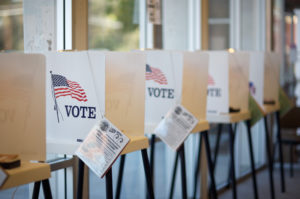
The Supreme Court reinstates Alabama’s voting maps, a federal court allows clinic referrals to abortion providers, and more…
IN THE NEWS
- The U.S. Supreme Court restored congressional maps in Alabama after a district court ordered the state to redraw them before holding primary elections in March. The district court had concluded that the maps likely violated the Voting Rights Act by suppressing Black votes. In a dissenting opinion, Justice Elena Kagan wrote that the majority decision “forces Black Alabamians to suffer” under “clear vote dilution.”
- A federal appeals court denied a request by Ohio and 11 other states to block health clinics, such as Planned Parenthood, from referring patients to abortion providers. The states protested a Biden Administration rollback of a Trump Administration rule forbidding federally funded clinics from making referrals to abortion providers. The states argued that they would receive less funding as a result of the new rule and be forced to make abortion referrals. The court ruled that the states failed to show the level of irreparable harm required to grant an injunction.
- The White House Task Force on Worker Organizing and Empowerment released a report of recommendations for the federal government to promote union organizing and membership. The report follows President Joseph R. Biden’s executive order on worker organizing, which created the task force and directed it to provide recommendations within 180 days. The task force is led by Vice President Kamala Harris and U.S. Department of Labor Secretary Martin Walsh, and its report offered dozens of recommendations, such as increasing workers’ awareness of their rights to organize and raising enforcement of labor standards, among others.
- The U.S. Securities and Exchange Commission (SEC) proposed changes to its whistleblower program rules. One of the proposed changes affirms the SEC’s authority to increase—and not reduce—an award to a whistleblower. The other proposed change prevents whistleblowers from receiving a lower award from a non-SEC whistleblower program. SEC Chair Gary Gensler stated that the proposed changes “would help ensure that whistleblowers are both incentivized and appropriately rewarded for their efforts in reporting potential violations of the law.”
- Certain state governors, including from New York and Illinois, announced plans to end mask mandates for indoor businesses in response to lower COVID-19 infection rates and hospitalization numbers, as well as high vaccination rates. In addition, the governor of Massachusetts announced a plan to end the mask mandate in public schools. The White House press secretary, Jen Psaki, stated that the Biden Administration continues “to recommend masking in areas of high and substantial transmission.”
- The U.S. Environmental Protection Agency (EPA) released a draft report from the agency’s Clean Air Scientific Advisory Council that recommends EPA strengthen air quality standards for soot. The recommendations followed EPA’s June announcement that it would reconsider the decision not to strengthen the standards for soot under the Trump Administration. The council’s recommendation to EPA noted that the existing standards are insufficient to protect public health and focused on the impact of soot pollution on cardiovascular health.
- The Centers for Disease Control and Prevention (CDC) announced proposed updates to its guidelines for opioid prescriptions. The updated guidelines are available for public review and comment through April 11. The existing guidelines went into place in 2016 and some experts reportedly credited the 2016 version with reducing the overprescription of opioids. In the updated guidelines, the CDC proposed lifting the recommended caps on dosage. The CDC’s announcement said that the guidelines are “voluntary” and are not intended to prevent physicians from prescribing treatment as they see fit.
- In a hearing before a U.S. Senate committee, Rostin Benham, head of the Commodity Futures Trading Commission (CFTC), advocated a “coordinated federal approach” to regulate cryptocurrency and other digital asset commodities. Benham stated that the growth of digital assets requires granting the CFTC additional resources and power to combat gaps in the regulatory supervision of these commodities. In a previous letter to Benham, legislators had reportedly asked about the CFTC’s oversight of cryptocurrencies and expressed the need to regulate digital commodities.
WHAT WE’RE READING THIS WEEK
- In an paper issued by the Brookings Institution, Matthew Fiedler, economic studies fellow at the USC-Brookings Schaeffer Initiative for Health Policy, and Timothy J. Layton, professor of health care policy at Harvard Medical School, discussed why Centers for Medicare and Medicaid Services (CMS) should abandon its proposal for a new method of “scoring” the health risks of patients enrolled in different insurance plans. Fiedler and Layton explained how the Affordable Care Act effectively requires money transfers from insurers who attract lower-risk enrollees to insurers attracting higher-risk enrollees. Fiedler and Layton argued that CMS should not adopt the proposed enrollee risk scoring rules because they would raise the risk scores for enrollees with lower anticipated costs and lower the risk scores of those enrollees with higher anticipated costs, altering the transfer amounts. Fiedler and Layton described how the transfer policy creates stability in the insurance market by encouraging insurers to serve different kinds of enrollees, which diversifies risk and increases competition. Fiedler and Layton predicted that the proposed CMS changes would cause an increase in premiums, encourage insurers to offer lower-quality plans, and reduce competition.
- In a report, the U.S. Government Accountability Office (GAO) found that as federal agencies increase the use of telework—otherwise known as remote work—during and after the COVID-19 pandemic, more reliable data is needed to oversee federal telework properly. GAO argued that the U.S. Office of Personnel Management (OPM), which collects data on federal telework, should improve the reliability of its data system’s ability to monitor error reports, integrate with other databases, and process internal controls. GAO recommended that Congress require OPM to develop a plan to address these weak points to provide an accurate picture of the challenges and benefits of federal agency telework.
- In an article published in the Yale Journal of Regulation Bulletin, Natalya Shnitser, associate professor at Boston College Law School, argued that the U.S. Department of Labor should update its regulations to address the governance and oversight of professional employer organizations, which can provide workplace benefits, such as retirement benefits and health insurance, to private employees. Furthermore, Shnitser explained that professional employer organizations operate using a “co-employment” model, meaning that professional employer organizations share responsibilities with a worker’s primary employer. But the existing federal benefits framework assumes there is a single employer, which results in what Shnitser referred to as a regulatory gap for professional employer organizations. Shnitser argued that the Labor Department should categorize professional employer organizations as financial intermediaries between employees and employers so that they can be subject to stricter regulations.
FLASHBACK FRIDAY
- In an essay in The Regulatory Review, Sam Batkins, former policy director at the American Action Forum, argued that valuing the cost of particulate matter, or soot, in the air was an important component of environmental policymaking. Batkins explained that litigants have historically argued over EPA’s calculations of the monetary benefits of reducing particulate matter because these calculations influenced air quality rulemakings and have been inconsistent. Batkins concluded that particulate matter regulations would “continue to cause controversy between the regulated and the regulators for many years to come.”



